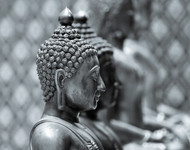Beginners guide to Buddhism - What is Buddhism?
Posted by Brett Almond
What is Buddhism?
Many say that Buddhism is a philosophy rather than a religion. One of the reasons for this is that worship is not directed towards a God or a creator. Buddhists are more concerned with the road to enlightenment - a state of being. Buddhism is a hands-on discipline that advises you not to take it on trust. It says to come and see for yourself.
The Buddha once said, “Monks don’t accept what I say just out of respect for me. Just as gold is tested in the fire, test my words in the fire of spiritual experience.”
Buddhism grew from the story of a man who lived 2,500 years ago and, through his learning and subsequent teachings, left a legacy to the world. Some Buddhists believe that the Buddha was the first person ever to attain enlightenment. He was a hero and an explorer who went where no one else had ever been. He had no map to follow, no textbook to refer to, no compass to confirm that he was going in the right direction. The Buddha was a spiritual pioneer, and that is why he is so revered.
Who was the Buddha?
The Buddha began life in the 6th century BC as Siddhartha Gautama, the son of a tribal leader, in an area that is now probably Nepal. Siddhartha had a prince-like standing in his tribe. From this privileged position, he began to wonder about the meaning of life and death and of growing old.
It is said that one day he met a sadhu, (literally, ‘good person’), who had given up all material possessions to go forth in search of truth. This must have been a major factor in inspiring Siddharta, at 29, to leave behind his comfortable life - and his wife and child - in order to find the truth.
He went in search of teachers, illuminated ones who could give him the knowledge he sought. He would absorb their teachings and then move on, valuing what he had learned but always feeling that there was something more, something that he was missing. For years he practised a programme of austerities, which in many ways amount to self-torture, during which he became weaker and weaker through long periods of fasting. He began to accumulate disciples, impressed by his great feats of asceticism. Eventually he realised that his austerities were not bringing him any closer to the truth, and he began to eat again.
Six years after leaving his home and family, he came to a place now known as Buddha Gaya, and stopped under a tree by a river. He started to relax his whole being, and stopped pushing so hard for the truth. Through meditation, he plunged deeper and deeper into his superconsciousness. No one knows how long he stayed there, but it was during this time that he attained the state of enlightenment, or nirvana - that Siddhartha Gautama became the Buddha.
It is said that during this period of illumination he saw all his previous lives, their consequences, and how, through many lifetimes, he was brought to this place. His path of improvement had now ended, for he had attained the ultimate, he had ascended to the realm of the Buddhas.
So what is enlightenment like?
Enlightenment cannot be expressed in words. Illumination, all-knowing, peace, calm, clarity, wisdom, profound love, and bliss, are words that merely hint at the wonders and absolute fulfilment that enlightenment represents.
Those who follow the Buddha’s teachings experience glimpses of enlightenment through their spiritual practice. Some would explain trying to describe enlightenment to a troubled soul as trying to explain the wonders of a rolling landscape, blue skies and the wind and sun to a child who has lived all his life in a cave. Whatever words you use to describe the scenery, nothing can come close to experiencing it yourself.
Why all the Buddhas?
We are partly spiritual and partly material beings. As we try to develop ourselves spiritually, it is sometimes reassuring to have physical reminders in our lives of what we are trying to achieve. There are many symbols, statues and icons in Buddhist tradition. Some try to represent enlightenment in physical form while others remind us of other states of being. For example, a statue of Shiva Nataraja (a dancing figure) represents the dance of the universe in which everything is connected in the rhythm of existence. If you are trying in your spiritual practice to connect with the wonder of this unity, you may have a statue of Nataraja in your house. By having him in the house, you are reminded constantly of his qualities.
Some people make shrines of a number of statues or objects that are special to them, and meditate or pray at this shrine. Having inner awareness of what the objects represent brings to mind their qualities. You may wish to leave an offering at a statue. The statue cannot eat or otherwise use your offering, but by leaving something at a statue you are making an energetic connection with what the statue represents. Because everything is connected, when you ‘feed’ the statue, you are in some way feeding a part of yourself.
What do Buddhists do?
In the East, Buddhism is often male-dominated and hierarchical and is practised by monks who have withdrawn from the world. Eastern Buddhists will spend many hours - sometimes days - meditating.
Since starting to take hold in the West in the 19th century, Buddhism has been evolving in an attempt to fit our different way of life. It has had to adapt to survive in the West, allowing the full participation of women and making it possible to practise Buddhism as part of daily life rather than in isolation from the world. Some purists would rather not see this happen, while others believe it is fantastic that many Westerners are finding practical ways to use Buddhism for the good of themselves and humanity.
While meditating, Buddhists try to clear their mind of every thought and emotion. Some may think that when they attain this goal everything becomes dull and empty, but in fact this is the point at which enlightenment comes.
It seems such a simple idea, but to make yourself clear for the Buddha energy to pass through you requires much practice. Some of this practice comes in meditation, but much comes in learning about yourself and why you react in certain ways to certain situations, so there is also a strong connection to psychology.
Summary
Buddhism is a tolerant teaching that takes the individual as the centre of the teachings. Many Buddhist books are concerned with individuals improving themselves. Buddhists believe that we return to this planet in many forms to help us on our path, and that over many lifetimes, and through right living and actions, we can all reach enlightenment. Some may attain enlightenment in this life while others may do so many centuries from now.
The Buddha created a path that had never been trodden before - a path along which others may follow. People who study Buddhism today are literally followers of the Buddha, trying to re-enact for themselves the great feat that the Buddha achieved. It is not an all-or-nothing religion. Those who practise experience periods that give them a taste of enlightenment and, once they have had a bite of the cake, often find they are hooked and their resolve to develop further becomes stronger and stronger.
Brett Almond
© holisticshop 2000. All rights reserved



